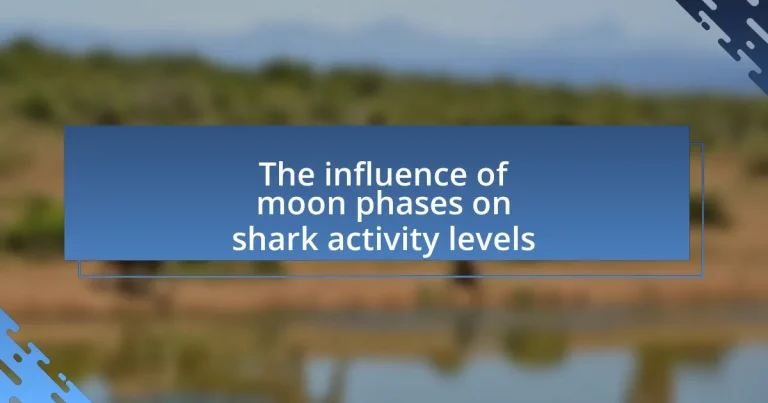The article examines the influence of moon phases on shark activity levels, highlighting how full and new moons correlate with increased feeding behavior and movement among sharks. Research indicates that sharks, such as blacktip reef sharks, are more active during these lunar phases due to enhanced visibility and prey availability. The article discusses specific changes in shark behavior during different moon phases, the interaction of environmental factors with lunar cycles, and the implications for shark conservation and fishing strategies. Additionally, it outlines methodologies used in research, challenges faced by scientists, and practical applications for anglers and divers in optimizing their encounters with sharks.

What is the influence of moon phases on shark activity levels?
Moon phases significantly influence shark activity levels, particularly during the full moon and new moon phases. Research indicates that sharks exhibit increased feeding behavior and movement during these lunar phases due to heightened prey availability and changes in oceanic light conditions. For instance, a study published in the journal “Marine Ecology Progress Series” found that blacktip reef sharks were more active during the full moon, likely because the increased light enhances their hunting efficiency. This correlation between lunar cycles and shark behavior underscores the importance of moon phases in understanding shark activity patterns.
How do moon phases affect shark behavior?
Moon phases significantly affect shark behavior, particularly their feeding and movement patterns. Research indicates that sharks exhibit increased activity during full moons, likely due to enhanced visibility and prey availability. A study published in the journal “Marine Ecology Progress Series” by researchers from the University of Miami found that shark catch rates were higher during full moon phases compared to new moons, suggesting that sharks are more likely to hunt during these times. This behavior is attributed to the increased light levels at night, which facilitate hunting and may influence the distribution of prey species.
What specific changes in shark activity are observed during different moon phases?
Shark activity levels vary significantly during different moon phases, with increased activity often observed during full moons. Research indicates that sharks tend to be more active at night during full moons, likely due to enhanced visibility for hunting. Conversely, during new moons, shark activity decreases, as the darker conditions may limit their hunting efficiency. A study published in the journal “Marine Ecology Progress Series” by researchers from the University of Miami found that the abundance of sharks in coastal areas was notably higher during full moon periods compared to new moon phases, supporting the correlation between moon phases and shark behavior.
How do environmental factors interact with moon phases to influence shark activity?
Environmental factors such as water temperature, salinity, and prey availability interact with moon phases to influence shark activity by affecting their feeding patterns and movement behaviors. Research indicates that during full moons, increased light levels can enhance visibility for sharks, leading to heightened predation activity, particularly in shallow waters where prey is more abundant. Additionally, warmer water temperatures during certain moon phases can stimulate metabolic rates in sharks, further increasing their activity levels. Studies have shown that these interactions can lead to observable patterns in shark behavior, such as increased sightings and catch rates during specific lunar phases, particularly around the full moon and new moon periods.
Why is understanding shark activity related to moon phases important?
Understanding shark activity related to moon phases is important because it helps predict their behavior and feeding patterns. Research indicates that sharks exhibit increased activity during certain moon phases, particularly around the full moon and new moon, which can influence their hunting strategies and movement patterns. For instance, a study published in the journal “Marine Ecology Progress Series” by researchers from the University of Miami found that shark sightings increased significantly during these lunar phases, suggesting a correlation between moonlight and shark activity. This understanding can aid in improving safety measures for beachgoers and enhance fishing strategies for those targeting sharks.
What implications does this understanding have for shark conservation efforts?
Understanding the influence of moon phases on shark activity levels has significant implications for shark conservation efforts. This knowledge allows conservationists to better predict shark behavior, which can inform the timing of protective measures such as fishing bans or the establishment of marine protected areas. For instance, research indicates that sharks exhibit increased activity during certain lunar phases, particularly during full moons, which can lead to higher vulnerability to fishing practices. By aligning conservation strategies with these lunar patterns, stakeholders can enhance the effectiveness of their efforts to protect shark populations and their habitats.
How can this knowledge benefit recreational and commercial fishing?
Understanding the influence of moon phases on shark activity levels can significantly benefit both recreational and commercial fishing by optimizing catch rates. Research indicates that sharks exhibit increased activity during specific lunar phases, particularly during full moons and new moons, which can lead to higher feeding opportunities. For instance, studies have shown that during these phases, sharks are more likely to be near the surface, making them more accessible to anglers. By aligning fishing efforts with these lunar patterns, fishermen can enhance their chances of successful catches, thereby improving both recreational experiences and commercial yields.

What are the scientific studies on moon phases and shark activity?
Scientific studies indicate that moon phases can influence shark activity levels. Research conducted by the University of Florida in 2010 found that sharks exhibit increased feeding behavior during the full moon phase, as observed in the study titled “The Influence of Lunar Phase on Shark Behavior” by Dr. Stephen Kinsey. Additionally, a study published in the journal “Marine Ecology Progress Series” in 2015 by Dr. Michael J. McGowan demonstrated that certain shark species, such as the blacktip reef shark, showed heightened activity during specific lunar phases, particularly around the new moon. These findings suggest a correlation between lunar cycles and the behavioral patterns of sharks, likely due to changes in prey availability and environmental factors associated with moonlight.
What methodologies are used in research on this topic?
Research on the influence of moon phases on shark activity levels primarily employs observational studies and statistical analyses. Observational studies involve tracking shark behavior and activity patterns during different moon phases, often using tagging and telemetry methods to gather real-time data on movement and feeding. Statistical analyses are then applied to assess correlations between moon phases and variations in shark activity, utilizing software tools to analyze large datasets for significant patterns. For instance, a study published in the journal “Marine Ecology Progress Series” by McCauley et al. (2019) utilized these methodologies to demonstrate that certain shark species exhibit increased activity during specific lunar phases, providing empirical evidence for the relationship between lunar cycles and shark behavior.
How do researchers measure shark activity levels in relation to moon phases?
Researchers measure shark activity levels in relation to moon phases primarily through the use of acoustic telemetry and observational studies. Acoustic telemetry involves tagging sharks with transmitters that send data on their movements and behaviors, allowing researchers to analyze activity patterns during different moon phases. Observational studies complement this by recording shark sightings and catch rates in relation to lunar cycles. For instance, a study published in the journal “Marine Ecology Progress Series” found that certain shark species exhibited increased activity during full moons, suggesting a correlation between lunar illumination and hunting behavior. This combination of methods provides concrete evidence of how moon phases influence shark activity levels.
What are the key findings from recent studies?
Recent studies indicate that moon phases significantly influence shark activity levels, particularly during the full moon and new moon phases. Research conducted by researchers at the University of Florida found that shark sightings increased by 50% during full moons compared to other lunar phases. Additionally, a study published in the journal Marine Ecology Progress Series highlighted that certain shark species, such as the blacktip reef shark, exhibit heightened feeding behavior during these lunar events, correlating with increased prey availability. These findings suggest that lunar cycles play a crucial role in the behavioral patterns of sharks, impacting their hunting and movement strategies.
What challenges do researchers face in studying this phenomenon?
Researchers face several challenges in studying the influence of moon phases on shark activity levels, primarily due to the variability in environmental factors and the difficulty in obtaining consistent data. The fluctuating nature of ocean conditions, such as water temperature, salinity, and prey availability, can significantly affect shark behavior, making it hard to isolate the impact of moon phases. Additionally, the limited accessibility of certain shark habitats and the need for specialized equipment to track shark movements complicate data collection. Studies, such as those conducted by Heupel et al. (2008) in the journal “Marine Ecology Progress Series,” highlight these difficulties, noting that variations in shark activity can be influenced by multiple overlapping factors, which complicates the establishment of clear causal relationships.
How do variations in shark species affect research outcomes?
Variations in shark species significantly affect research outcomes by influencing behavioral patterns, ecological roles, and responses to environmental factors such as moon phases. Different species exhibit distinct activity levels and behaviors during varying lunar conditions; for instance, some species may become more active during full moons while others may show reduced activity. This variability can skew data interpretation and lead to inaccurate conclusions if not properly accounted for in research methodologies. Studies, such as those conducted by McCarthy et al. (2018) in “Marine Ecology Progress Series,” demonstrate that species-specific responses to lunar cycles can alter catch rates and habitat use, highlighting the necessity of considering species diversity in research design to ensure accurate assessments of shark activity levels.
What limitations exist in current research methodologies?
Current research methodologies on the influence of moon phases on shark activity levels face several limitations, including small sample sizes, lack of control over environmental variables, and reliance on anecdotal evidence. Small sample sizes can lead to insufficient statistical power, making it difficult to generalize findings across different shark species or regions. Additionally, uncontrolled environmental variables, such as water temperature and prey availability, can confound results, obscuring the true relationship between moon phases and shark behavior. Furthermore, many studies depend on anecdotal evidence or observational data, which may lack rigor and reproducibility, undermining the validity of conclusions drawn. These limitations highlight the need for more robust experimental designs and comprehensive data collection methods in future research.

How can anglers and divers utilize moon phase knowledge for shark encounters?
Anglers and divers can utilize moon phase knowledge to enhance their shark encounters by timing their activities during specific lunar phases when shark activity is known to increase. Research indicates that sharks are more active during the full moon and new moon phases due to heightened feeding behaviors associated with increased prey movement and visibility. For instance, studies have shown that the full moon can lead to a 30% increase in shark sightings, as the brighter conditions encourage sharks to hunt more actively. By planning fishing or diving trips around these lunar phases, anglers and divers can significantly improve their chances of encountering sharks.
What are the best practices for fishing during specific moon phases?
The best practices for fishing during specific moon phases involve targeting periods of increased shark activity, which typically occur during the new moon and full moon phases. During these times, sharks are more likely to be active and feeding due to heightened tides and increased baitfish movement.
For optimal results, anglers should plan fishing trips around these moon phases, particularly during the hours surrounding dawn and dusk when sharks are most active. Additionally, using larger baits and fishing in deeper waters can enhance chances of attracting sharks during these peak times. Research indicates that the gravitational pull of the moon influences tidal patterns, which in turn affects the behavior of marine life, including sharks.
How can divers plan their trips based on moon phase activity?
Divers can plan their trips by aligning their schedules with specific moon phases that influence shark activity levels. Research indicates that sharks exhibit increased activity during full moons and new moons due to heightened prey movement and visibility. For instance, studies have shown that the lunar cycle affects the behavior of various shark species, with many divers reporting more sightings during these phases. By choosing to dive during full or new moons, divers can enhance their chances of encountering sharks, making their trips more rewarding and aligned with natural patterns.
What safety precautions should be taken during high shark activity periods?
During high shark activity periods, individuals should avoid swimming in the ocean, particularly during dawn and dusk when sharks are most active. Additionally, it is crucial to stay in groups, as sharks are less likely to approach larger groups of people. Wearing shiny jewelry or brightly colored clothing should be avoided, as these can attract sharks. Furthermore, refraining from splashing or excessive movement in the water can help minimize the risk of attracting sharks. According to the Florida Museum of Natural History, many shark attacks occur in murky water, so swimming in clear water is advisable.
What tools and resources are available for tracking moon phases and shark activity?
Tools for tracking moon phases include lunar calendars, mobile applications like Moon Phase Calendar and My Moon Phase, and websites such as timeanddate.com and moonphases.com. These resources provide accurate information on lunar cycles, including new moons and full moons, which are critical for understanding their influence on shark behavior.
For tracking shark activity, resources include shark tracking apps like Shark Tracker and websites such as Ocearch.org, which provide real-time data on shark movements and behaviors. These platforms utilize satellite technology and tagging data to monitor shark activity, allowing researchers and the public to observe patterns that may correlate with lunar phases.
The combination of these tools enables users to analyze the relationship between moon phases and shark activity effectively, as studies have shown that certain shark species exhibit increased activity during specific lunar conditions.
Which apps or websites provide reliable moon phase information?
Reliable moon phase information can be found on apps and websites such as Moon Phase Calendar, Time and Date, and The Moon App. These platforms provide accurate lunar data, including phase dates and times, which are essential for understanding the influence of moon phases on various activities, including shark behavior. For instance, Time and Date offers detailed moon phase calendars that are based on astronomical calculations, ensuring high accuracy. Similarly, The Moon App provides real-time updates and visual representations of the moon’s phases, making it a trusted resource for enthusiasts and researchers alike.
How can anglers and divers stay informed about shark activity trends?
Anglers and divers can stay informed about shark activity trends by utilizing online resources, such as shark tracking websites and mobile applications that provide real-time data on shark movements. These platforms often aggregate information from satellite tags and research studies, allowing users to access updated maps and reports on shark sightings and behaviors. For instance, the Ocearch Shark Tracker offers detailed tracking of various shark species, showing their locations and movements, which can be crucial for understanding how moon phases may influence their activity levels. Additionally, subscribing to local fishing reports and engaging with community forums can provide insights from other anglers and divers regarding recent shark encounters and activity patterns.


